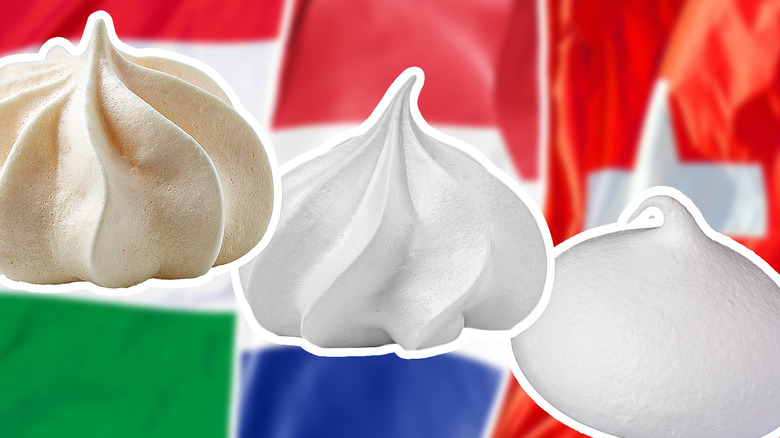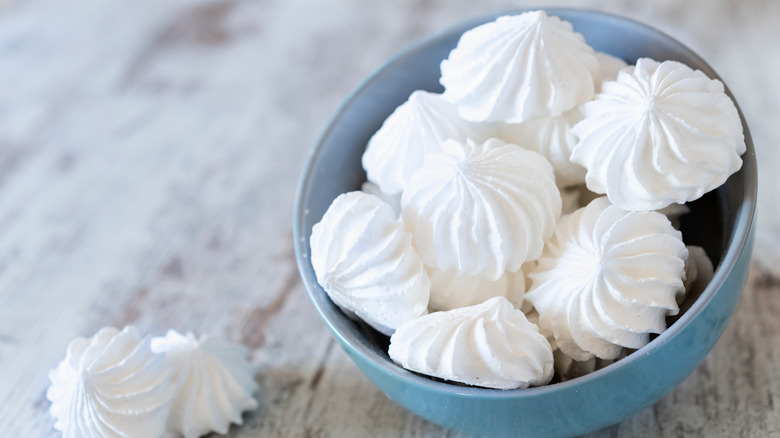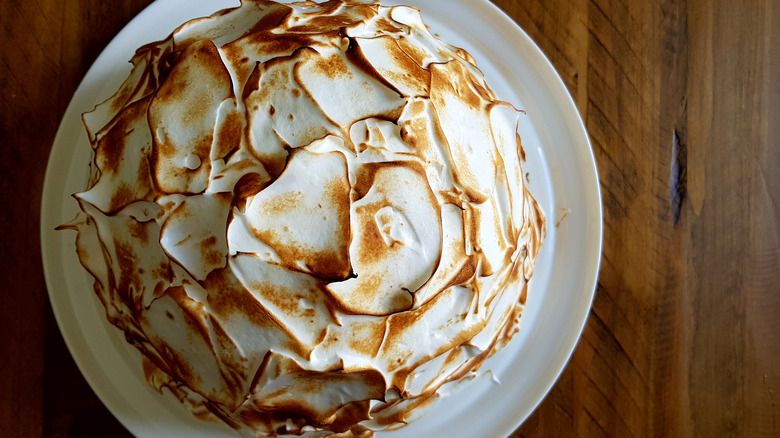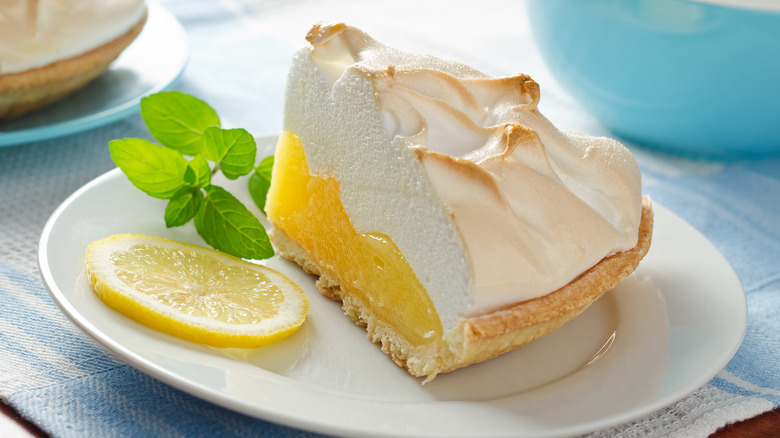French Vs Swiss Vs Italian Meringues: What's The Difference?
For a dessert made with extremely simple ingredients, the various styles of meringue can hide a world of difference. It's already a pretty magical product, with basic egg whites being transformed into light and silky wisps of sweetened cream with a distinct marshmallow flavor. And yet within that impressive transformation, there is even more going on. Meringues can range from crispy, to thick and creamy, to fluffy, all depending on how you treat your egg whites. That versatility and variety are what make meringue such a popular ingredient in baking and desserts, and of course, you have an irreplaceably delicious taste, too.
Meringues come in three classic styles: French, Italian, and Swiss. All three require the same elements: egg whites, sugar, and heat. However, they differ in how those three things get cooked together. The one unifying element beyond the ingredients is that the egg whites are always whipped, which incorporates air into the meringue to give it structure. The different cooking styles lead to significantly varied outcomes, particularly in texture. Italian is the thickest and most stable of meringues, while French is the softest and most airy, with Swiss hitting a middle ground between those two. The textural difference means each one gets used in separate situations, with cookies, pies, and cakes each using distinct forms of meringue, but because of their use in so many recipes, a knowledge of all three meringues is essential for a baker.
French meringue is soft and light
French meringue is usually considered the easiest to make, but it results in the least stable of the styles. To make a French meringue, egg whites are beaten by themselves until they thicken and start to form soft peaks. At that point, sugar is slowly sifted in as you continue to beat the egg whites, very similar to how you would make whipped cream. Cream of tartar can also be incorporated to help it hold together. The egg whites stay raw and uncooked the whole time, which is why this style is least able to maintain its structure. It also means the meringue must be cooked some other way before you can eat it. And while the French form is relatively easy, its lack of stability means it can collapse if you overbeat it.
Because it's raw and delicate, French meringue is usually piped and cooked in the oven, or incorporated into other recipes for flavor and texture. A classic use is meringue cookies – it's piped into rounds and baked, forming a crisp exterior and soft, pillowy interior. French meringue can also be gently folded into batters to help make them airy and light. Genoise cake is a favorite made this way, or layered into cakes before they are baked. It can even be used as a light topping for things like key lime pie, but just make sure it gets cooked under a broiler or other heat source before you eat.
Swiss meringue is smooth and versatile
If you want something that is more stable and denser than French meringue, but still silky, Swiss is your style. Swiss meringue mixes the sugar and egg whites together before beating, and then slowly cooks the mixture over a double boiler as it's whisked. The meringue should only be lightly cooked, so you want to keep your bowl from coming into direct contact with the water. It also needs to be beaten constantly to keep the whites from overcooking and firming up too much. Once the sugar is fully dissolved and the mixture is warm, around 120 to 130 degrees Fahrenheit, it's taken off the heat. The meringue then gets whisked quickly to give it volume, it should double in size, and then more slowly to let it cool and stiffen up.
Swiss meringue's middle ground texture and stability make it the most all-purpose. It's still soft enough to be baked into cookies or other crispy desserts, but since it's cooked and thicker it can be used as layering without extra baking, or as a topping. Swiss meringue makes a great compliment to pies and can be used to make a layer cake or spread over a baked Alaska. It can also be made into a lighter, less sweet alternative to frosting as Swiss meringue buttercream.
Italian meringue is thick and creamy
Italian meringue is the hardest to pull off, but it produces a rich and glossy meringue that makes a beautiful addition to desserts. This style starts the same way as French, by whipping plain eggs white, but pushes it a little farther into stiff peaks. The sugar is added in the form of a hot syrup, which needs to hit a temperature of 240 degrees Fahrenheit. Then, the syrup is slowly drizzled in as the meringue continues to be beaten, which cooks the egg whites without scrambling them. The whisking then continues until the mixture is thick and cool. The precision of the hot sugar syrup makes this meringue tricky. The finished results however are worth the effort. The heat from the syrup makes Italian meringue the most stable form, and it can be shaped into beautiful peaks and swirls that will hold their shape. The thick texture is also decadent and wonderfully creamy.
Like Swiss meringue, Italian is most frequently used as a decoration and topping. It's the best meringue for finishing pastries and frosting cakes, and its stability makes it great for layering without collapsing. Classic pies like lemon meringue usually call for the Italian style. Its creamy texture also makes it great for spooning over fresh fruit or a tart sorbet.
There is no "best" meringue style, only the one that's best for you and your recipe, and they are all worth giving a shot.



